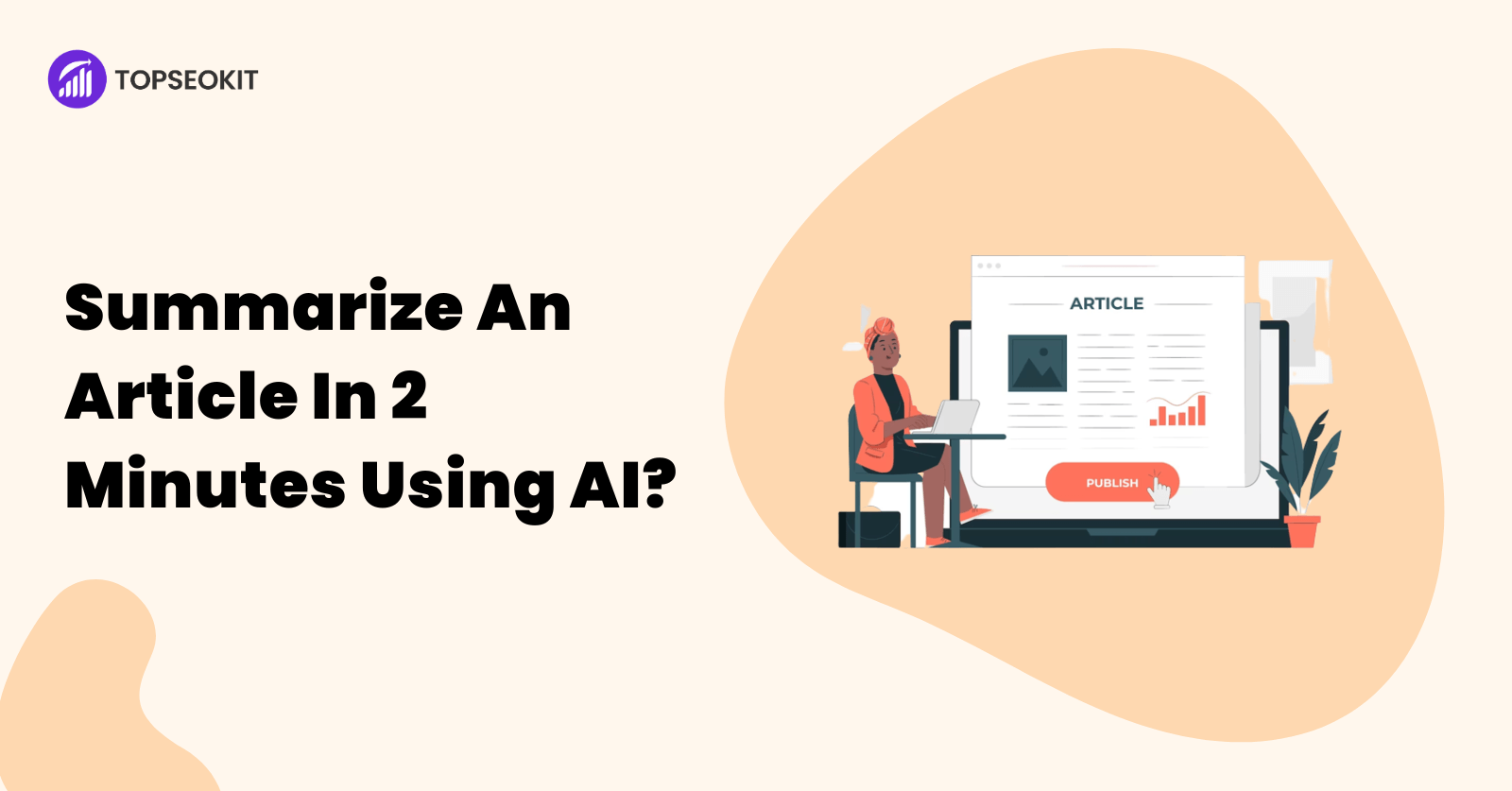Table of Contents
- Importance of summarizing articles
- Understanding Article Summarization
- The Rise of AI in Summarization
- Step-by-Step Guide: Summarizing an Article Using AI
- Tips for Effective AI Summarization
- Case Study
- Future of AI in Article Summarization
- Conclusion
- FAQs
1. Importance of summarizing articles
In this era of rapid technological progress and information overload, the ability to summarize article and process information efficiently has become crucial.
With the constant barrage of lengthy articles, reports, and studies, being able to extract the key ideas and restate them concisely is an invaluable skill. Tools like AI summarizers have made gaining the essential insights from any piece of content nearly instantaneous. The future looks bright for AI’s role in streamlining information and making it more accessible.
Whether you’re a student trying to condense a lengthy research paper, a professional sifting through numerous reports, or a casual reader trying to get the gist of a news article, summarizing helps you extract key points and understand content quickly.
Now, imagine doing this in just two minutes or less. Sounds impossible? Not anymore. Welcome to the era of Artificial Intelligence (AI). AI has revolutionized many aspects of our lives, and article summarization is no exception.
This blog post will introduce you to the fascinating world of AI-powered summarization, guide you on how to use it, and highlight its benefits. By the end of this post, you can summarize an article in just two minutes using AI.
2. Understanding Article Summarization

Before we delve into AI, let’s first understand article summarization. Article summarization is shortening a text document to retain critical points and maintain the text’s overall meaning. It’s about distilling the most vital information from the source material.
Traditionally, summarizing an article is a manual process. You would read the entire article, identify the key points, and then rewrite these points in a condensed form.
For example, you were summarizing a news article about a recent election. In that case, read the entire piece and write a shorter version highlighting the election’s winner, voter turnout, and significant events.
But what role does AI play in article summarization? AI can automate the summarization process, making it faster and more efficient.
AI algorithms can scan an entire article, identify critical points, and generate a summary in seconds. It saves time and ensures consistency and objectivity in the outlines. In our election article example, an AI tool could quickly produce a resume with the same critical points without human bias or error.
3. The rise of AI in Summarization

As you delve into the artificial intelligence (AI) world, you’ll find that it has made significant strides in many areas, including text summarization.
Brief History of AI in Text Summarization
In the early days, text summarization was a manual and time-consuming task. However, with the advent of AI, the process has been revolutionized. AI’s journey in text summarization began with simple algorithms that could extract critical sentences based on word frequency.
Over time, these algorithms evolved, incorporating more complex linguistic rules and semantic understanding.
For instance, in the late 2010s, transformer-based models like BERT and GPT were introduced. These models could understand the context and generate human-like text, making them ideal for tasks like summarization.
Advantages of Using AI for Summarization
AI has several advantages when it comes to summarizing text:
- It’s incredibly efficient. What could take human hours, AI can accomplish in seconds.
- AI can handle large volumes of text, ideal for summarizing lengthy reports or articles.
- AI can provide consistent summaries, free from human bias or error.
Examples of AI Tools Used in Summarization
There are several AI tools available for text summarization. OpenAI’s GPT-3, for example, is a powerful language model that can generate coherent and concise summaries. Similarly, devices like SMMRY and SummarizeBot use AI algorithms to extract and present key points from a text and present them in a summarized form.
4. Step-by-Step Guide: Summarizing an Article Using AI
Choosing the Right AI Tool for Summarization
The first step in summarizing an article using AI is to choose the right tool. Consider factors like the text’s complexity, the summary’s desired length, and the tool’s ability to understand the context. For instance, if summarizing a technical paper, use a sophisticated tool like GPT-3.
Uploading or Inputting the Article into the AI Tool
Once you’ve chosen your tool, the next step is to input the article. Depending on the device, it could involve copying and pasting the text, uploading a document, or providing a URL.
Running the Summarization Process
After inputting the article, you’ll need to run the summarization process. It usually involves clicking a button or running a command. The AI tool will then analyze the text and generate a summary.
Reviewing and Refining the AI-Generated Summary
Finally, it’s essential to review the AI-generated summary. While AI is powerful, it could be better. Check the overview for accuracy and coherence, and make any necessary adjustments. Remember, the goal is to create a summary that accurately represents the original text in a condensed form.
5. Tips for Effective AI Summarization
As you embark on your journey with AI summarization, keeping a few essential tips in mind to ensure the most effective results is necessary.
Understanding the Limitations of AI Summarization
While AI is a powerful tool, it’s not without its limitations. AI summarization tools can sometimes miss nuances or subtleties in the text. They may not always capture the author’s tone or style. Understanding these limitations can help you better utilize AI tools and set realistic expectations.
Ensuring the Summary Maintains the Original Article’s Context
One of the critical aspects of effective summarization is maintaining the original context. When reviewing the AI-generated summary, ensure it accurately represents the main ideas and arguments of the original text. For instance, if you’re summarizing an article about climate change, the summary should convey the article’s stance and critical points on the issue.
Verifying the Accuracy of the Summary
Accuracy is paramount in summarization. Always cross-check the AI-generated summary with the original text to accurately reflect the content. If there are any discrepancies or inaccuracies, make the necessary adjustments.
6. Case Study: Successful AI Summarization
Let’s delve into a real-life example better to understand the power and potential of AI summarization.
Presentation of a Real-Life Example Where AI Summarization Was Used Effectively
Consider the case of a multinational corporation that needed to summarize quarterly reports for its global teams. With hundreds of pages of data and analysis, manual summarization was time-consuming and prone to errors.
The corporation turned to AI summarization, explicitly using a tool like GPT-3. The AI tool quickly and accurately summarized the reports, saving the corporation valuable time and resources.
Analysis of the Process and Results
The corporation first inputted the reports into the AI tool. After running the summarization process, the AI tool generated concise summaries that accurately captured the critical points of the words. The resumes were then reviewed and refined to ensure accuracy and coherence.
The results were impressive. The corporation was able to disseminate the summaries to its global teams quickly, ensuring everyone was up-to-date with the latest data and analysis. This case study demonstrates the power of AI summarization and its potential to revolutionize tasks like report summarization.
7. Future of AI in Article Summarization
Advancements in AI summarization technology are rapidly progressing. AI systems are becoming more innovative and sophisticated at analyzing lengthy, complex articles and distilling them into concise yet comprehensive summaries.
Some predicted advancements include AI that can summarize even longer, more involved articles with higher accuracy and coherence. AI may also get better at summarizing articles in a personalized, customized way based on an individual’s interests and needs.
Potential impact on various industries
The potential impact of improved AI summarization technology is huge across many industries. For example, AI could summarize lengthy academic papers or book chapters for students in education.
In business, AI might translate industry reports, news articles, and other documents to keep professionals up-to-date efficiently. AI could even help summarize electronic health records and medical studies for doctors and patients. The possibilities are endless.
Conclusion
In conclusion, AI for article summarization has significant importance and benefits. It can save you valuable time by quickly distilling essential information from lengthy, complex pieces.
The future of AI in this field is bright, with continued advancements on the horizon that will make summarization even more accurate, personalized, and valuable. I encourage you to explore the available AI summarization options and see how they might help streamline your reading and research.
AI summarization tools will only improve over time, so take advantage of them now to improve your productivity and learning. The potential impact on how we consume and share information is enormous.
FAQs
How do you summarize an article on artificial intelligence?
AI can analyze the text of an article to identify the most important sentences and concepts, then combine those into a concise summary.
Can I use AI to summarize an article?
Yes, many AI services and tools are available that can automatically summarize articles for you.
What is the best AI for summarizing articles?
Some of the best AI options for summarizing articles include Google’s AutoSummarize, Anthropic’s Claude, and OpenAI’s GPT-3.
What is the fastest way to summarize an article?
The fastest way to summarize an article is to use an AI summarization service which can generate a summary in just a few seconds.

Leave a Reply